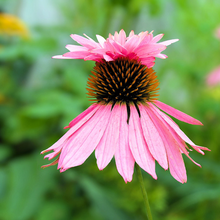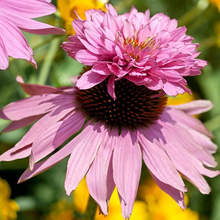Echinacea 'Doubledecker' is a distinctive coneflower cultivar with a two tiered flower form that develops a second ring of pink petals atop the central cone in its second year. The vibrant daisy like flowers bloom over a long summer season and stand tall on sturdy stems that are excellent for cutting. Its unique structure adds visual intrigue to mixed borders and pollinator gardens alike, while seed heads persist into winter offering ornamental value and food for wildlife.
Height & Spread: 30 - 36 in x 18 - 24 in
Bloom Time: Mid summer to early fall
Light Requirements: Full sun
Soil Preference: Well drained soil, moderately rich to average fertility
Watering Needs: Low to moderate; drought tolerant once established
Deer Resistance: Generally avoided by deer due to tough stems and aromatic foliage
Native Status
While not a naturally occurring species, this selection is derived from the native Echinacea purpurea, which is native to central and eastern North America.
WILDLIFE & INSECTS
Butterflies
- Visited by Monarchs, Eastern Tiger Swallowtails, Painted Ladies, and Great Spangled Fritillaries drawn to its bright nectar rich blooms.
Bees
- Supports native bumblebees, carpenter bees, and sweat bees, as well as honeybees seeking pollen and nectar throughout summer.
Moths
- Night blooming and crepuscular moths including Sphinx moths visit flowers for nectar in the evening hours.
Birds
- Finches, especially American Goldfinches, feed on the dried seed heads in fall and winter.
Spacing & Landscape Use
Spacing Recommendations:
- Space plants 18 - 24 in apart to promote airflow and upright growth without overcrowding.
Landscape Placement:
- Suitable for mixed perennial beds, cottage gardens, meadow plantings, and wildlife friendly borders. The tall eye catching blooms also make excellent focal points or additions to pollinator corridors.
Companion Plants
- Aster novae-angliae (New England Aster) - Late blooming aster that complements the pink coneflowers with vivid purple flowers and similar upright form.
- Heliopsis helianthoides (False Sunflower) - Bright yellow blooms add sunny contrast and share pollinator appeal through summer.
- Liatris spicata (Blazing Star) - Adds vertical interest with purple spikes and thrives under similar sun and soil conditions.
- Monarda fistulosa (Wild Bergamot) - Aromatic foliage and lavender flowers support bees and butterflies while enhancing textural diversity.
- Salvia nemorosa 'Caradonna' (Wood Sage) - Compact spiky purple blooms enhance the color range and attract bees and hoverflies.
- Schizachyrium scoparium (Little Bluestem) - Native grass that pairs well with Echinacea’s structure and provides nesting habitat for insects and birds.



